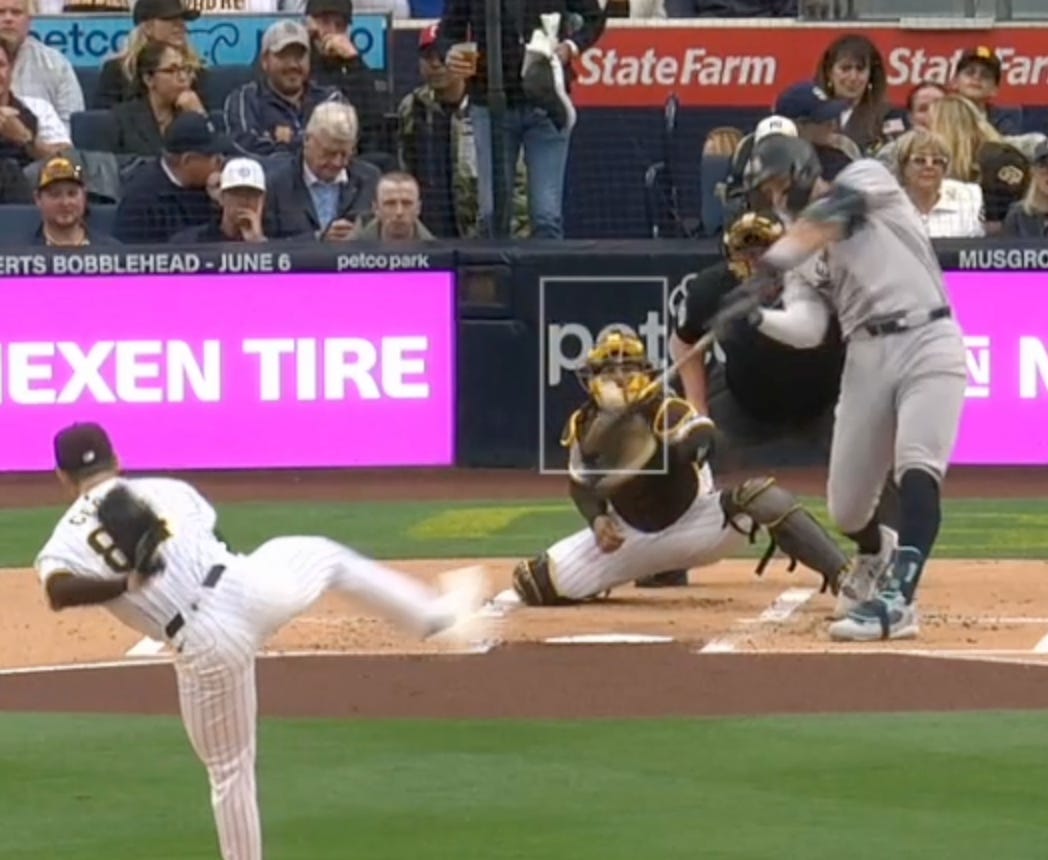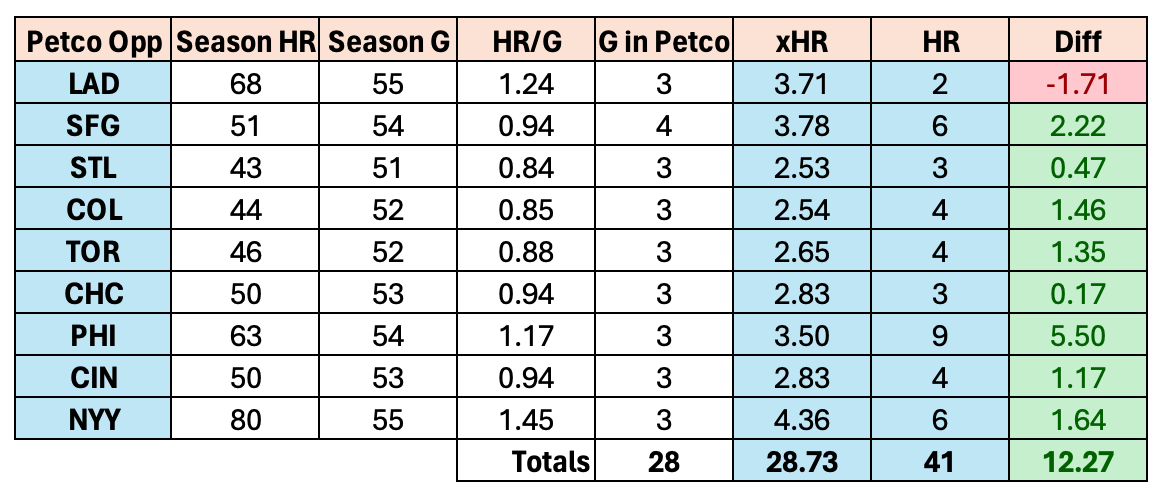It’s tempting to draw sweeping conclusions about the identity of a team after each episode of success or futility, but that’s just not how information accrues in baseball. Sunday the Dodgers lost their fifth game in a row getting swept by the Reds in the process, the Phillies lost their series against the Rockies, and the Padres defeated the Yankees. It would be nice to think those outcomes say a lot about the teams involved, but alas they do not. The series against the Yankees did add some incremental understanding of the Padres outlook, though, and we should update accordingly.
Shortening The Game
The Padres have found something in Jeremiah Estrada. He has demonstrated the ability to be successful in high leverage, and his underlying stuff is incredible. He has more measured induced vertical break on his four seam fastball than Shota Imanaga, who had a feature written on his four-seamer due to its effectiveness despite an average velocity of only 92 MPH. Estrada has an average four seam fastball velocity of 96.7 MPH. Of the 15 highest average induced vertical breaks on a four seamer in the MLB, Estrada has the fastest average velocity. He pairs it with a splitter that averages 83.8 MPH that he uses instead of a changeup, and which breaks steeply downwards with a ridiculous 13.7 inches of arm side (towards a right handed hitter) horizontal break. His third pitch is a slider that breaks about 6.3 inches glove side and likely plays up due to its very different pitch shape from his two primary offerings, and carries a very good 34.8% whiff rate this year. He’s struck out the last 10 hitters he’s faced, all swinging, and 15 of the last 18: This is still a small sample size. But when results are this extreme with a highly plausible underlying physiologic explanation, it suggests there’s something real here:
Courtesy: @MLB
Part of why ‘rising’ four seam fastballs are so difficult for hitters is they trick the brain by appearing to be headed for one part of the zone but they don’t drop as much as the brain calculates for a normal object with gravity and hence appear to ‘rise’. The hallmark of this is an enormous amount of swings under the ball. This shows up in the stats where the league average fly ball% is 26.1%, while Estrada sits at 46.2%, near the very top of the league. He also induces an impressive 15% infield fly ball rate which is tied with Imanaga and top 25 in MLB. It shows up on the tape as well. Here are the last four strikeouts by way of the four seamer prior to the Yankees series:
These are the results you’d expect. Swinging just under the path of the ball. Which is why it’s so interesting to juxtapose what we saw against the Yankees. Here are the shots of the three strikeouts Estrada got against the Yankees with the four seamer:
Maybe it’s just coincidence that their hitters weren’t swinging under the fast ball. But the Yankees are an absurdly well prepared team. The organization undoubtedly had noted Estrada decimating the Braves and Reds hitters last week. Perhaps the explanation for their hitters swinging over the four seamer despite never having faced Estrada before has to do with being properly informed about his pitch shapes and making swing adjustments. It’s hard to know. But it augurs well that they still struggled to make contact.
Relievers like this shorten the game. And that’s why it’s encouraging to see some signs that the front end is also showing some resurgence.
One Step Forward
On Sunday Joe Musgrove made his second start since returning from the IL, and pitched a tidy 5.1 innings striking out five and walking none. His velocities were just fine and his spin rates were up across the board:
There is enormous leverage on Musgrove being both healthy and effective. The Padres task is still just to survive the regular season, and getting at least league average production from Musgrove can mean a few extra wins across the next 100+ games compared with the alternatives. Those margins are sure to matter. It’s going to be hard to know when to trust that he’s truly back to form, but doing what he did Sunday against the best team in baseball is as good a first step as can be hoped. That’s the positive side of what we saw from the starting rotation in the Yankees series.
Two Steps Back
What we saw happen to Darvish in game one is hard to explain. He gave up seven runs and four home runs in the first four innings Friday. There were no concerning findings in his underlying velocity or pitch shape results. And he was able to gut out 5.2 innings to spare the bullpen some. As good as the Yankees are, no team can sustain an offensive outpouring like they showed. The Yankees teed off on Darvish to such a degree some wondered if Darvish might have been tipping pitches. Others speculated about whether Campusano may have been giving away location with his early glove positioning. More likely it was just a bad outing against one of the best lineups in the league. But there was at least one similar game last season in which Seth Lugo ultimately suggested he was likely tipping pitches against the Dodgers. Outings where hitters are all over every offering of an otherwise very good pitcher are alarming, and maybe warrant a little paranoia. But Darvish will most likely be fine.
In game two on Saturday Dylan Cease was touched up in the box score, but he largely pitched very well going 6.2 innings while striking out nine and not walking any. The issue in his performance is easy to diagnose. In the first inning after going ahead 0-2 against Aaron Judge this was the two strike offering:
Here’s the still frame of the 0-2 pitch location:
What are we doing here?
Later in the fourth Judge got a rally going that would lead to the other two runs Cease allowed:
Again the still frame:
This came without the additional sin of serving it in pitcher-favorable count leverage, but still it’s the same location to a hitter that just hit a similar pitch 429 feet. It’s not an oversimplification to say that game two could have gone very differently if the Padres had simply not thrown center-cut meatballs to the best hitter in the game. That should be modifiable. Cease was excellent otherwise. The Padres starting rotation continues to show tantalizing potential.
The Yankees series didn’t feel close, but games two and three were very competitive. And the Padres took the finale. That’s not nothing against a team that looks to have almost no weaknesses like the Yankees.
No Place Like Home
After salvaging the win on Sunday the Padres moved to 11-17 at home (excluding the ‘home’ game in Korea), and it’s fair to wonder what underlies such a miserable record. Some of it is what we saw all weekend, the long ball. The Padres have given up the second most home runs in their home stadium:
This isn’t just being propped up by a couple of bad series, visiting teams have almost universally out performed their typical home run rates at Petco this year:
In total visiting teams have hit about 12 more home runs in Petco than would be expected based on their rest of season averages. It’s really hard to know what’s underlying this, but just looking at the league landscape as whole a few things jump out:
The ballpark that’s given up the fewest home runs overall and to opposing teams is Coors field. And some of this is playing two ‘home’ games in Mexico City where seven home runs were hit, but even adding that their total would only leap frog the pitcher friendly Oracle Park. Also, the Great American Ballpark which finished 2nd, 1st, and 3rd in the past three seasons in home runs allowed is firmly in the middle of the pack. Maybe it’s a really weird year for park factors, but a lot of this screams early season variance. There are so many games in the baseball season that it can feel like a lot of baseball has been played when only a third of the season has gone by.
Still, the enormous amount of home runs the Padres have given up at home is a big part of why their record there is so poor, and if there’s a systematic reason for it, uncovering it needs to be high on the Padres list of priorities. We’ll certainly pay attention to this as time goes by. As of now it’s very hard to provide a clear explanation.
But there’s another piece, too. The games at Petco have been really tough. Cumulatively the Padres home opponents have played to a .524 winning percentage. The weighted average for the number of games against each opponent still yields a formidable .521 winning percentage:
A .521 winning percentage would be good for sole possession of the second wild card spot. It would also be the second hardest strength of schedule any team has faced this year behind only the White Sox who’s .532 strength of schedule is more reflective of their own 15-39 record than scheduling.
You can use this to extrapolate a bit of information about expected vs actual performance. If you presume the underlying skill of the Padres is that of a .521 team, then the expected performance against their foes at home would be an even .500 or 14-14. Their actual record is three games off of this. If they are not quite as good as a .524 team then you would expect their record against a cumulatively .524 schedule to be a bit worse than .500, maybe 13-15, not terribly far off from their actual:
These are pretty unconvincing exercises but the road record suggests they’re better than the abysmal version of themselves they’ve been at home. In the absence of a clear reason why they should do worse at home we should probably keep an open mind about whether the Padres performance so far definitely suggests they will continue to be bad at home. It might just be part of an extremely difficult first third of the season schedule. Overall the Padres have had the eleventh hardest strength of schedule in the league at .508, and there’s some evidence that they’re frequently getting the best versions of the teams they’ve faced. Here are the starting pitchers they’ve faced at home and their ERA against the league as a whole:
It’s hard to overstate how difficult the first third of the season has been. Almost every early season Cy Young favorite is on this list. Here are the starters they’ve faced on the road, many duplicates of the list above:
The starting pitching the Padres have faced on the year is well above league average, and that should even out over the next 100+ games. We can hope.
Outlook
The Padres have piled up several impressive wins and several, to borrow a phrase from Major Garrett, mindless excruciating losses. They are 28-28 on Memorial Day despite a very difficult schedule. That’s not good, but it’s not bad either. They’ve made it through the first third of the season still in the playoff hunt. When the year started that might’ve been the most we dared hope. Still breathing. Still alive for the second act.
















Just saved me from doing a “strength of schedule” deep dive today. One thought I had was removing the games played against the padres to see how the strength of schedule looks. Also, thought about what the strength of schedule looks like for the remainder of the season.
Of course, if they continue to underperform vs sub-.400 teams, it’s all moot.